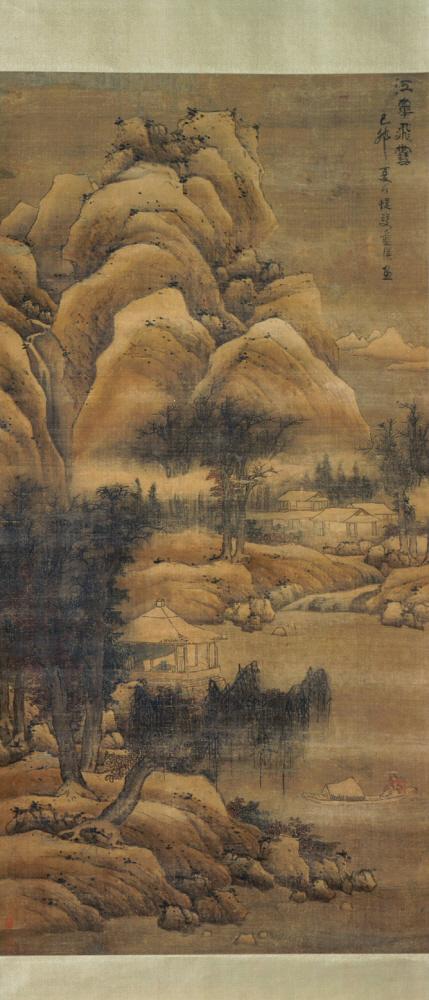Activity
Whirling Snow on the River Bank

Whirling Snow on the River Bank, 1639, by Lan Ying (1585–1664). China; Ming dynasty (136–1644). Hanging scroll; ink on silk. Transfer from the Fine Arts Museums of San Francisco, Gift of Mrs. Austin Hills, B69D56.
Mountain Water Painting
In the foreground of this painting, we see the riverbank with its rocky shore, clumps of trees, and a man in a boat drifting towards an open pavilion. In the middle ground, a group of houses is nestled in a wooded valley, and a stream enters the river in a series of shallow rapids. Behind the houses, hills rise in succession, culminating in a towering mountain; in the far distance, another mountain range is faintly visible. The word for landscape painting in Chinese is shanshui hua which means “mountain water painting,” indicating the importance of these opposite landscape elements in Chinese painting. Mountains rise up; water flows down. The Chinese saw mountains and water as symbols of the eternal process of change and of the balancing yang and yin, hard and flowing.
Let’s look at how the artist paints snow and water. Most often he paints them by not painting them — that is by leaving areas blank while painting the forms around the water or beneath the snow. Here, Lan Ying has used brush and ink to define the forms of rocks, mountains, trees, and houses. He has then applied graded washes of pale ink and light yellow and brown tones to fill in the forms and darken the silk for all the areas that are not covered with snow. The white, unpainted areas, such as the tops of mountains, houses, and rocks appear blanketed with snow. (Silk darkens with age, so the unpainted areas in this picture are not as white now as they were originally.) A few dots of white were applied to some of the black accent dots, heightening the snowy effect. The river is hardly painted at all, indicated only by the boat, by the way the shoreline is defined, and by a few horizontal lines. The firmly painted rocks exposed in the stream and the shaded crevices around the waterfall allow us to imagine the water flowing around and through them.
About the Artist
Lan Ying (1585–1664) spent his early years in Zhejiang province in the area of Hangzhou. He showed great artistic talent as a young boy and was determined “to become famous through painting.” He was trained and worked as a painter in the conservative tradition of the Zhe School, a school of mainly professional artists who perpetuated the style of the Southern Song (1127–1279) Imperial Painting Academy after the fall of the Song in 1279. By the time he was in his twenties he seemed to have moved north into the Songjiang region of Jiangsu province where his name appears in association with those of the prominent collectors, critics, and painters of the scholar-amateur tradition (dominated by the ideas and style of Dong Qichang). Here the gifted young artist was able to meet and paint with his peers and to study old paintings. As a result of his contact with new ideas and his ability to see and study new and old paintings, he explored various styles and techniques in developing his own.
In this large painting on silk of a monumental mountain landscape, Lan Ying draws on his early training in the gongbi, or meticulous, style of careful delineation and laying on of colored washes; however, he also incorporates techniques learned from his later association with the scholar’s world in his more calligraphic use of line and dots and in the structure of the composition. There are no continuous outlines but forms are suggested by broken lines of the severed band stroke. Lan Ying creates the mountain mass, and its fissures and valleys, by carefully applying many layers of yellow ochre and burnt sienna washes alternated with strokes of water to blur their edges. Unpainted silk on the top of the mountains, trees, houses, and boat suggests the thin blanket of snow. Confused dots enliven the surface and suggest sparse vegetation.




